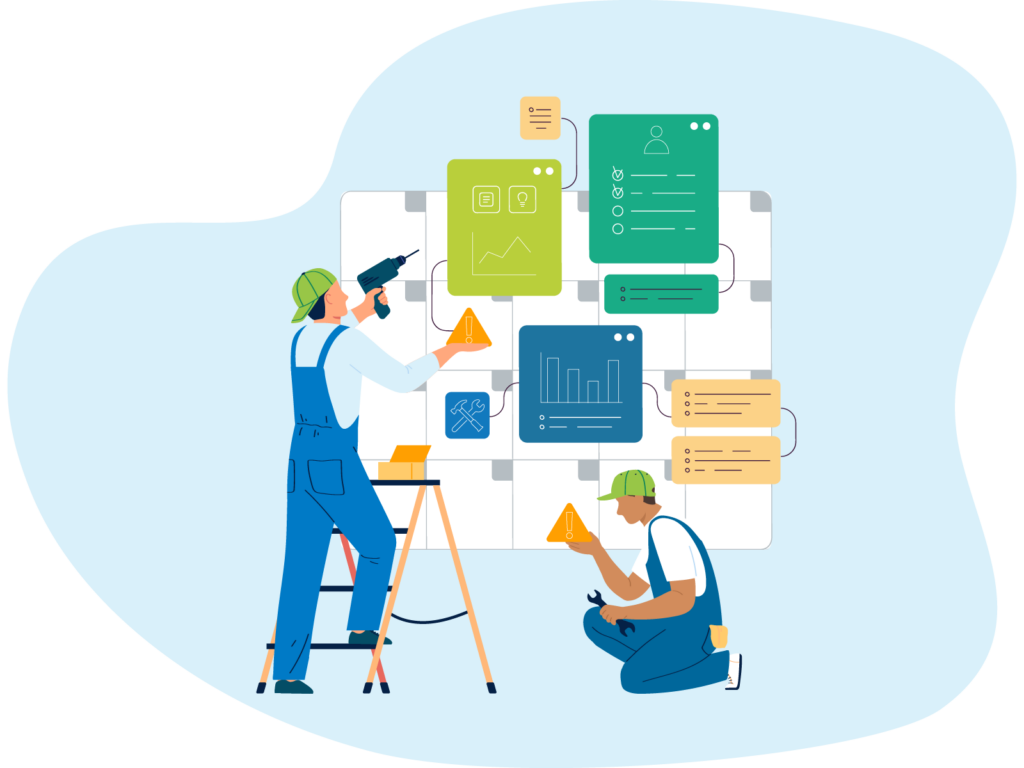How CAFM systems help unlock hybrid working
As more and more organisations turn to hybrid working models, here we explore how a CAFM system makes this approach more attainable.
It is becoming increasingly obvious that hybrid working is the future for modern workplaces.
Today’s employees, particularly younger generations, want to balance their time between home and the office, and the onus is on companies globally to facilitate this.
However, as was evident in how businesses adapted their working practices in response to the COVID-19 pandemic, introducing a hybrid working model is easier said than done. Moving beyond the ‘traditional’ workplace dynamic has been a struggle for many.
With this in mind, below we will explain how CAFM systems make the transition to hybrid working more achievable, so companies can realise the full benefits.
What is hybrid working?
Hybrid working (or flexible working) is when employees split their time between their conventional workplace and working remotely. Rather than commit entirely to a full-time workplace regime or 100% remote work, this is meant to offer a ‘best of both worlds’ middle ground.
This is a working model that had been bubbling under the surface for many years, exploding into life when the pandemic compelled many to switch to remote working. Now, hybrid working is something a large percentage of workers would like to see become the norm across all industries.
Why is hybrid working important?
Hybrid working is not a passing phase. It is the future – and it can offer numerous benefits for businesses in the short and long terms:
Talent acquisition
As noted, many employees are fully on board with the idea of flexible working:
-
98% of people would choose to work remotely, at least part-time, for the rest of their careers (Buffer)
-
80% of people expect to work from home at least three times per week (Owl Labs)
-
One in three workers would be willing to quit their job if it didn’t offer flexible working (Robert Half)
-
Over 70% of office workers want more flexible remote work options, while over 65% want more in-person time with colleagues (Microsoft)
These statistics demonstrate that, if companies want to appeal to today’s candidates, hybrid working is likely towards the top of their wish list.
Job satisfaction
In a similar vein, hybrid working can lead to a significant rise in happiness and satisfaction. With employees more focused on flexibility, giving them a stronger sense of freedom in how and where they work can be a huge boost to their wellbeing. This can then lead to higher staff retention and better engagement.
75% of people feel more trusted at work when they are allowed to working remotely (Owl Labs)
Greater productivity
Every employee is different, and will work more efficiently and effectively in different environments. For every person that thrives working remotely, others might feel more comfortable in the office.
A hybrid working model enables companies to provide the most suitable environment for their employees to perform their best. As a result, they will be more productive, and a greater asset to the company overall.
49% of UK workers feel they are more productive working from home (IWFM)
Better collaboration
One of the overwhelming challenges of remote working is communicating with colleagues. A hybrid model lessens this struggle. Employees can come together in the workplace when they need to collaborate, then be at home when working independently.
The need to manage hybrid working models
There is no denying the advantages a hybrid working model can offer. More attractive proposition to modern candidates. Improvements in productivity and efficiency. Flexibility over office layouts and requirements.
However, these benefits can only be unlocked if the model is well-managed, backed by access to the right technology. Without this structure in place, the advantages of hybrid working can become an unending series of challenges to business processes.
The challenges of hybrid working
Risks to employee wellbeing
While hybrid working can do wonders for employee wellbeing, it can also have the complete opposite effect if it is not handled properly.
-
Remote workers may feel isolated or siloed off if regular communication is not maintained, hurting their mental health
-
Remote staff may be resentful of opportunities or any bias shown to in-house workers, or in-house teams might resent the flexibility afforded to remote teams
-
A lack of structure might cause confusion over when employees are needed on-site or not, affecting their happiness and concentration
Problems with connectivity
Communication is vital. Without access to dependable video conferencing equipment and other means to connect with team members both at work and at home, communication can be derailed. This will almost certainly have a negative effect on productivity, efficiency and overall company performance.
Unstructured office layouts
When moving to a hybrid working model, a traditional office layout may no longer be fit for purpose. Employees will not use the same desks every day. Virtual meeting rooms will be critically important. Service and climate control requirements will change depending on who is on-site at any given time.
Plus, companies transitioning from a full-time model to hybrid working could find themselves spending over the odds on energy bills, as they will no longer need to support a full contingent of employees.
Fears over health and safety
Especially in response to COVID, it is essential that companies give employees returning to the office confidence over the health and safety of their workspace. Without this, employees could be nervous about returning or being on-site, affecting their performance.
How CAFM systems help make hybrid working achievable
Many of the challenges of switching to a hybrid model will fall squarely at the feet of facilities management professionals. They will need to ensure that their layout and structure is well-suited to this new way of working.
Fortunately, an effective CAFM system can make all the difference here, tackling many of the challenges above and helping companies prepare for the inevitable shift to flexible working.
1. Smarter space management
First, CAFM software can play a vital role in making space planning more dynamic and agile. By analysing workspaces over time and tracking usage, FM professionals can build a much stronger understanding of how to best utilise this space, both to improve employee wellbeing and minimise costs.
For example, spatial data could indicate that certain meeting rooms or offices are no longer actively used as fewer people are on-site. With this information at hand, FM teams can propose ways that these spaces can be repurposed so they are no longer a drain on resources.
Plus, this insight could lead to the creation of more interactive working environments, improving on-site collaboration.
2. Managed facility bookings
Switching to flexible working could spur the need for hot-desking and employees booking their own workspaces. A CAFM solution, such as our own Facility Booking Suite, makes this simple for staff to manage:
-
Locations can be filtered by dates, times, number of attendees and more, presenting a clear view of all available spaces
-
Employees can quickly schedule out desks, rooms and other workspaces in a matter of clicks
-
Alerts can be sent to FM teams once a booking is made, prompting them to prepare the room or desk for that person’s requirements
3. Improved health and safety
Facilities management software can give on-site employees total reassurance over the cleanliness of their working environment.
For example, once an employee is finished using their desk, an alert can be sent to cleaning staff to prepare the space for the next user.
In addition, a dedicated cleaning app can maintain a complete audit trail of every area cleaned throughout the day, saved directly into a central CAFM platform. Managers can then check these to ensure all tasks are being performed.
Through this technology, employees can enter their workplace with complete confidence over their safety and wellbeing.
4. Enhanced monitoring and communication
Effective CAFM software ensures FM professionals can actively monitor activity across an estate. From asset maintenance and real estate data, through to energy consumption levels, these platforms give a clear oversight of all the data they need in straightforward dashboards.
With a system like MRI Evolution, this can be done from anywhere on any device. FM professionals can view their required data in real-time at their convenience, and enjoy more streamlined tasks.
Furthermore, employees can be empowered to create their own tasks through an app like ChatLog. This is then immediately passed to the FM team, who can arrange for the problem to be resolved without having to be on-site.
5. Remote resource management
Finally, by investing in sensor technology, companies can enhance their hybrid working experience through the Internet of Things (IoT).
By connecting these to CAFM technology, FM professionals can plan workspaces based on occupancy levels. Lighting, heating, ventilation and more can be controlled automatically or remotely.
This reduces the need for FM professionals to be present at all times, and ensures optimal working environments for those on-site. This will help to unlock the productivity benefits of hybrid working, and lead to substantial energy savings.
Establishing your own hybrid working environment with CAFM
There is no escaping the pull of hybrid working. Today’s employees have spoken, and it is increasingly important that companies have the structure in place to support this working model.
We hope that this article has helped you understand why a CAFM system should be a core component of this structure. As we have highlighted above, this transition has the potential to make life a lot more complicated for FM professionals and building managers.
An up-to-date CAFM solution like MRI Evolution is integral to overcoming the challenges and empowering FM teams to evolve with the times. With this in place, employers can be reassured that their workplace is well-managed at all times, so they can focus on the finer details of their hybrid working model.
Discover how MRI Evolution can become the core of your FM operations now and for the future – get in touch with our team today for more information.
Facilities Management software
Leading solutions for property occupiers, owners and service providers & contractors.
Get a demo
Discover the key trends and challenges impacting facility managers
From the adoption of new technologies to the need to adapt practices to suit today’s hybrid working requirements, Facility Managers are being asked to balance numerous responsibilities and priorities. Download our webinar that delves into the ever-ch…

